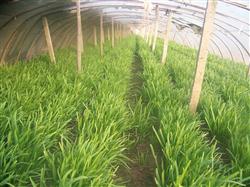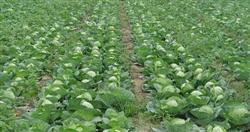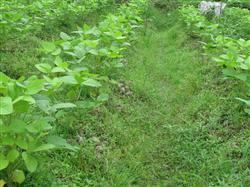How to get rid of weeds when planting leek in greenhouse?

How to get rid of weeds when planting leek in greenhouse? Please introduce the method of planting leek in greenhouse by transplanting. After transplanting, pendimethalin, propranolol and Zhong Dingling can be selected for soil closure treatment. The application of 330 g / L EC 150 ml or 48% EC 200-250 ml per mu, plus 50 kg water spray, can control a variety of grass weeds and some broad-leaved weeds, which is safer for leeks. A variety of broad-leaved weeds can be controlled by spraying 50% prometryne wettable powder 100-150 grams per mu. It is best not to use Pocaojing on sandy soil and sandy loam soil to prevent drug damage caused by drug leaching into the root of leek after repeated irrigation. Old root leek has strong drug resistance, in addition to the above agents, fluralin, ethoxyflurane and other agents can also be used to control weeds. If you look at fields with more Gramineae weeds, such as Mai Niang, you can spray with 48% trifluralin EC 100-150 ml per mu. In order to avoid the impact on the growth of leek, spray as far as possible, avoid liquid contact with leek. Fluralin is easy to volatilize and photolysis failure, after spraying, the ploughing mixture is 1-3 cm. For fields mixed with Gramineae weeds, broadleaf weeds and sedges, 50-60 ml of fruit 24% ethoxyfluoxane EC can be sprayed per mu. When etherified with ethoxyfluoxane, brown spots will appear on the leaf tip of leek after being unearthed, and the spots can spontaneously ignite and disappear after a few days. These insecticides are all soil sealing agents and have poor control effect on older grasses, so weeds should be pulled out manually first. In general, the old root leek field should be sprayed with herbicide once a knife is cut, and the herbicide should be applied after the wound has healed. When the medicine is applied when the wound does not heal, the medicine enters from the wound, and it is easy to cause drug damage. If Pocaojing is used when the wound is not healed, it will inhibit the photosynthesis of leek, reduce the number of times on the market, narrow the leaves and decrease the quality. After spraying fluralin and other herbicides, we should pay attention to the ventilation and ventilation of the greenhouse, otherwise the concentration of the volatile herbicide is too high, or the drug dissolves into the water on the greenhouse film and drips into the leaves of the new leek, which is easy to cause drug damage to the leek. When Gramineae weeds occur in the field during the growing period of leek, quizalofop and floropyrine can be used to control them. When Gramineae weeds and broad-leaved grasses are mixed, spraying ethoxyflurane has a better weed control effect if the grass age is younger, but it is easy to produce burn spots on the leek leaves and affect the appearance. The grass damage is serious, especially when the persistent root malignant broad-leaf weeds and sedges occur seriously, if the leek has a certain growth, you can consider cutting the leek first (the weeds are not cut) and covering the stubble properly with a clean map. then spray 200g / L chlorofluoropyloxyacetic acid EC or herbicide pine to control malignant broad-leaf weeds and sedges in the field. Among them, chlorofluoropyloxyacetic acid has good control effect on broad-leaved weeds and cypermethrin has good control effect on sedge. These two kinds of medicine may produce certain drug harm to leek, it is best not to spray directly during the growing period of leek. Small area test should be carried out before large area application, and then the area should be expanded after success. Click to get more leek planting techniques click to get more herbicide application techniques click to get more pesticide application techniques
- Prev

What kind of weed control is used to grow vegetables?
What kind of weed control is used to grow vegetables? Please refer to the following methods to control weeds in planting vegetables: 1. Chemical weeding of cruciferous vegetables such as cabbage, radish, cabbage, cauliflower, rape, etc., 48% trifluralin EC is selected before seedling or transplantation after sowing, and each mu (667m2) is used.
- Next

How does growing soybeans prevent weeds?
How does growing soybeans prevent weeds? Please introduce the main weeds for planting soybeans: crabgrass, barnyardgrass, goosegrass, chenopodium, green bristlegrass; broad-leaved weeds: amaranth, snakehead, iron amaranth, Abutilon theophrasti Summer soybeans are usually sown in June, in the season of high temperature and rainy, weeds occur fiercely, densely, and long.
Related
- Fuxing push coffee new agricultural production and marketing class: lack of small-scale processing plants
- Jujube rice field leisure farm deep ploughing Yilan for five years to create a space for organic food and play
- Nongyu Farm-A trial of organic papaya for brave women with advanced technology
- Four points for attention in the prevention and control of diseases and insect pests of edible fungi
- How to add nutrient solution to Edible Fungi
- Is there any good way to control edible fungus mites?
- Open Inoculation Technology of Edible Fungi
- Is there any clever way to use fertilizer for edible fungus in winter?
- What agents are used to kill the pathogens of edible fungi in the mushroom shed?
- Rapid drying of Edible Fungi

